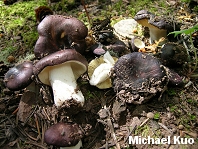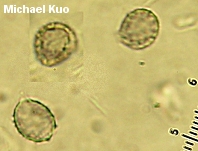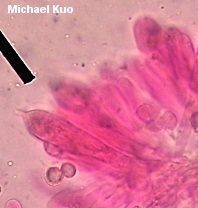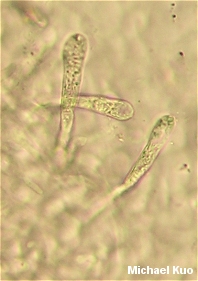| Major Groups > Gilled Mushrooms > Pale-Spored > Russula > Russula cinereovinosa |

|
Russula cinereovinosa [ Basidiomycetes > Russulales > Russulaceae > Russula . . . ] by Michael Kuo Known from the southwestern United States, Russula cinereovinosa is a dead ringer for the better known western species "Russula atroviolacea" (which may be misnamed; see the comments below), differing only in microscopic features and ecology: Russula cinereovinosa grows under conifers while Russula atroviolacea is apparently associated with willows. Thus, comparison of microscopic details may be necessary to identify this mushroom with certainty. Fatto (2000) distinguished Russula cinereoviolacea from Russula atroviolacea on microscopic differences. A type study of the latter species revealed slightly larger spores with higher ornamentation (to 1.2 µ high), pleurocystidia that project prominently, and fatter pileocystidia (7-16 µ wide); "[t]hese consistent differences," Fatto argued, "preclude any equivalence." A very similar russula occurs in California, where it is often labeled "Russula atroviolacea." However, it is unclear whether the name is being properly applied, especially since the description in H. D. Thiers's treatment of Russula in California (1997b) calls for "poorly differentiated pileocystidia"--a statement that could not be accurately applied to either Russula atroviolacea or Russula cinereovinosa. Burlingham's original description of Russula atroviolacea (1915--not 1970 as stated by Thiers) calls for a red mushroom (collected by L. O. Overholts under willows in Colorado) that becomes purple only when dried; in fact Burlingham specifically keys Russula atroviolacea away from the "vinous-purple to dark purple" species and towards the "red" species in her section Veternosae. Perhaps the purple California species, the purple Russula cinereovinosa, and the red Russula atroviolacea are all the same genetic species despite differences in morphology and ecology (in which case the oldest name, Russula atroviolacea, should be used)--or perhaps there are two or three entities, with the California species potentially unnamed. Russula cinereovinosa was originally named "Russula cinereopurpurea" (Fatto, 2000)--but had to be re-named (Fatto, 2002) to Russula cinereovinosa when it was discovered that the first name had already been used by Krombholz (1845). Russula murrillii is another similar western species; it has a mild taste and spores that feature prominent connecting lines that usually form reticulated areas. Description: Ecology: Mycorrhizal with conifers, including ponderosa pine, Engelmann spruce, and subalpine fir; growing alone, scattered, or gregariously; August; previously documented from Cochise County, Arizona and Colfax County, New Mexico; recorded here from La Plata County, Colorado. Cap: 3-9 cm; convex when young, becoming broadly convex to flat, with or without a shallow depression; dry, or sticky when fresh; smooth; shiny; deep grayish purple to deep brownish purple (OAC 524); the margin often lined by maturity; the skin peeling roughly one-third to halfway to the center. Gills: Attached or running slightly down the stem; close; often forking near the stem; creamy at first, but soon orangish yellow. Stem: 3-6 cm long; 1-2.5 cm thick; whitish, with an occasional purplish streak; dry; smooth. Flesh: White; brittle; not changing when sliced. Odor and Taste: Odor not distinctive; taste slowly slightly to moderately acrid. Chemical Reactions: KOH on cap surface orange. Iron salts on flesh and stem surface negative, very slightly pinkish, or dull tan. Spore Print: Dull yellow. Microscopic Features: Spores 7-9.5 x 6-8 µ; elliptical; with low, primarily isolated warts .3-.7 µ high; connectors scattered, usually not forming reticula. Pleurocystidia scarcely projecting; fusoid-clavate, mucronate, or capitellate. Pileipellis a cutis beneath a turf-like upper layer of hyaline elements with rounded to subacute apices; pileocystidia abundant, cylindrical to clavate, 4-8 µ wide, positive in sulphovanillin and refractive-ochraceous in KOH. REFERENCES: (Fatto, 2000) Fatto, 2002. (Kibby & Fatto, 1990; Fatto, 2000; Fatto, 2002.) Herb. Kuo 08130801. This site contains no information about the edibility or toxicity of mushrooms. |
© MushroomExpert.Com |
|
Cite this page as: Kuo, M. (2009, March). Russula cinereovinosa. Retrieved from the MushroomExpert.Com Web site: http://www.mushroomexpert.com/russula_cinereovinosa.html |



